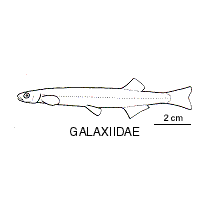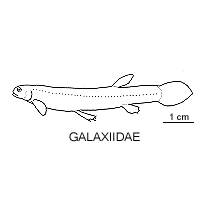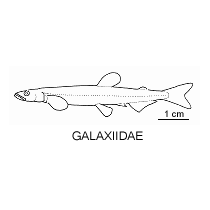- Classification
- ACTINOPTERYGII
- SALMONIFORMES
- GALAXIIDAE
Family GALAXIIDAE
More Info
|
Family Taxonomy |
Australian species of the family Galaxiidae were reviewed and figured by McDowall & Frankenberg (1981). The family comprises about 40 species in eight genera, with 22 species in four genera found in Australia. Begle (1991) has combined the Aplochitonidae with the Galaxiidae, which is followed by Nelson (1994). The aplochitonins were reviewed by McDowall (1971), who recognised two genera for two species of peladillos from South America (Aplochiton) and one species of Tasmanian whitebait from Australia (Lovettia). Tarmo Raadik is currently revising the Galaxias olidus complex and is describing a number of new species. Debate continues as to the placement of Lepidogalaxias salamandroides. Recent studies by Li et al (2010) and McDowall and Burridge (2011) suggest that Lepidogalaxias is the sister group to all other euteleostean fishes. |
|
Family Distribution |
Restricted to temperate waters of the Southern Hemisphere, with species in Australia, New Zealand, New Caledonia, South America and South Africa. Although galaxiids primarily freshwater fishes, some species are diadromous with marine post larval and juvenile stages. Some species are pelagic, whereas others are live on or near the bottom. |
|
Family Description |
Most galaxiids have no fin spines, scales or adipose fins, the dorsal and anal fins are posterior and opposite and the body is elongate and tubular. Aplochitonins have a short-based, anterior dorsal fin, posterior ventrals and an adipose fin. Lepidogalaxias is scaled. |
|
Family Size |
Generally species reach less than 250 mm, although one species attains 600 mm. |
|
Family Feeding |
Galaxiids feed on a wide variety of invertebrates, including insects, crustaceans, polychaetes and molluscs. |
|
Family Reproduction |
At least one South American species of aplochitonin apparently breeds in either marine or fresh water, while the Australian species is anadromous, living most of its life in the sea, but spawning in freshwater rivers. |
|
Family Commercial |
During their return to fresh water, galaxiids are known as whitebait, and are of minor commercial importance in Tasmania. |
|
Author |
Bray, D.J. 2018 |
References
Allen, G.R., H. Midgley & M. Allen. 2002. Field guide to the freshwater fishes of Australia. I-xiv + 1-394 pp.
Begle, D.P. 1991. Relationships of the osmeroid fishes and the use of reductive characters in phylogenetic analysis. Syst. Zool. 40(1): 33–53.
Frankenberg, R. 1969. Studies on the evolution of galaxiid fishes with particular reference to the Australian fauna. Ph.D. Thesis. Univ. of Melbourne, Melbourne.
Li, J, R. Xia, R.M. McDowall, J.A. Lopez, G. Lei & C. Fu. 2010. Phylogenetic position of the enigmatic Lepidogalaxias salamandroides with comment on the orders of lower euteleostean fishes. Molecular Phylogenetics and Evolution 57: 932-936.
McDowall, R.M. 1971. Fishes of the family Aplochitonidae. J. R. Soc. N.Z. 1(1): 31–52 figs 1–12.
McDowall, R. M. 1978a. A new genus and species of galaxiid fish from Australia (Salmoniformes: Galaxiidae). Journal of the Royal Society of New Zealand 8: 115–124.
McDowall, R.M. 1978. Sexual dimorphism in an Australian galaxiid. Australian Zoologist 19: 309–314.
McDowall, R.M. 1979. Fishes of the family Retropinnidae (Pisces: Salmoniformes) – a taxonomic revision and synopsis. Journal of the Royal Society of New Zealand 9: 85–121.
McDowall, R.M. 1984. Southern hemisphere freshwater salmoniforms: development and relationships. American Society of Ichthyologists and Herpetologists Special Publication 1: 150–153.
McDowall, R.M. 1988. Diadromy in fishes: migrations between freshwater and marine environments. Croom Helm, London.
McDowall, R.M. 1997. The evolution of diadromy in fishes (revisited) and its place in phylogenetic analysis. Reviews in Fish Biology and Fisheries 7: 443–462.
McDowall, R.M. 1997. Afinities, generic classification and biogeography of the Australian and New Zealand mudfishes (Salmoniformes: Galaxiidae). Rec. Aust. Mus. 49:121–137.
McDowall, R.M. 1998. Phylogenetic relationships and ecomorphological divergence in sympatric and allopatric species of Paragalaxias (Teleostei: Galaxiidae) in high elevation Tasmanian lakes. Environmental Biology of Fishes 53: 235–237.
McDowall, R. M. 1999. Caudal skeleton in Galaxias and allied genera (Teleostei: Galaxiidae). Copeia 1999: 932–939.
McDowall, R.M. 2001. The principal caudal fin ray count – a fundamental character in the galaxioid fishes. New Zealand Journal of Zoology 28: 395–405.
McDowall, R.M. 2001. Diadromy, diversity and divergence: implications for speciation processes in fishes. Fish and Fisheries 2: 278–286.
McDowall, R.M. 2002. The origin of the salmonid fishes: marine, freshwater . . . or neither. Reviews in Fish Biology and Fisheries 11: 171–179.
McDowall, R.M. 2003. Variation in vertebral number in galaxiid fishes (Teleostei: Galaxiidae): a legacy of life history, latitude and length. Environmental Biology of Fishes 66: 361–381.
McDowall, R.M. 2007. On amphidromy, a distinct form of diadromy in aquatic organisms. Fish and Fisheries 8: 1–13.
McDowall, R.M. & Burridge, C.P. 2011. Osteology and relationships of the southern freshwater lower euteleostean fishes. Zoosystematics and Evolution 87(1): 7-185.
McDowall, R.M. & Frankenberg, R.S. 1981. The galaxiid fishes of Australia. Rec. Aust. Mus. 33(10): 443–605 figs 1–47.
McDowall, R.M. & W. Fulton. 1978. A revision of the genus Paragalaxias Scott (Salmoniformes: Galaxiidae). Aust. J. Mar. Freshw. Res. 29: 93–108.
McDowall, R.M. & Nakaya, K. 1988. Morphological divergence in the two species of Aplochiton: a generalist and a specialist. Copeia 1988: 233–236.
Merrick, J.R. & G.E. Schmida. 1984. Australian Freshwater Fishes. Biology and Management. John R. Merrick. Pp. 409.
Nelson, J.S. 2006. Fishes of the World. New Jersey : John Wiley & Sons 4th Edn 601 pp.
Raadik, T.A. 2014. Fifteen from one: a revision of the Galaxias olidus Günther, 1866 complex (Teleostei, Galaxiidae) in south-eastern Australia recognises three previously described taxa and describes 12 new species. Zootaxa 3898(1): 1-198.
Sakurai, S., Ali, M.A. & Collin, S.P. (1990) Adaptive radiation of the retina in Galaxiidae (Salmoniformes). Australian Journal of Zoology 38: 173-186
Waters, J.M. & R.W.G. White. 1997. Molecular phylogeny and biogeography of the Tasmanian and New Zealand mudfishes (Salmoniformes: Galaxiidae). Aust. J. Zool. 45: 39–48.
Waters, J.M., L.H. Dijkstra & G.P. Wallis. 2000. Biogeography of a southern hemisphere freshwater fish: how important is marine dispersal? Mol. Ecol. 49.
Waters, J.M., J.A. López & G.P. Wallis. 2000. Molecular phylogenetics and biogeography of galaxiid fishes (Osetichthyes: Galaxiidae): dispersal, vicariance, and the position of Lepidogalaxius salamandroides. Systematic Biology 49(4): 775-795.
Waters, J.M. & McDowall, R.M. 2005. Phylogenetics of the Australasian mudfishes: evolution of an eel-like body plan. Molecular Phylogenetics and Evolution 34: 417–425.
Waters, J.M. & Wallis, G.P. 2001. Cladogenesis and loss of the marine life-history phase in freshwater galaxiid fishes (Osmeriformes: Galaxiidae). Evolution 55: 587–597.
Waters, J.M. & White, R.W.G. 1997. Molecular phylogeny and biogeography of the Tasmanian and New Zealand mudfishes (Salmoniformes: Galaxiidae). Australian Journal of Zoology 45: 39-48.
Williams, R.R.G. 1997. Bones and muscles of the suspensorium in the galaxioids and Lepidogalaxias salamandroides (Teleostei: Osmeriformes) and their phylogenetic significance. Records of the Australian Museum 49(2): 139-166.
Williams, R.R.G. 1996. Jaw muscles and suspensorium in the Aplochitonidae (Teleostei: Salmoniformes) and their possible phylogenetic significance. Marine and Freshwater Research 47: 913–917.
































































































































































